2025届高考英语二轮复习专题二语法填空备考课件(共110张)
文档属性
| 名称 | 2025届高考英语二轮复习专题二语法填空备考课件(共110张) |  | |
| 格式 | ppt | ||
| 文件大小 | 933.0KB | ||
| 资源类型 | 教案 | ||
| 版本资源 | 通用版 | ||
| 科目 | 英语 | ||
| 更新时间 | 2025-04-27 22:51:08 | ||
图片预览

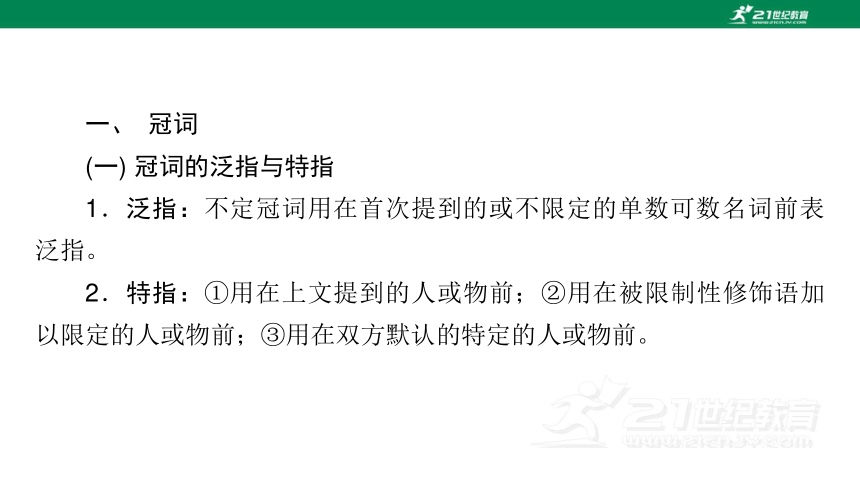
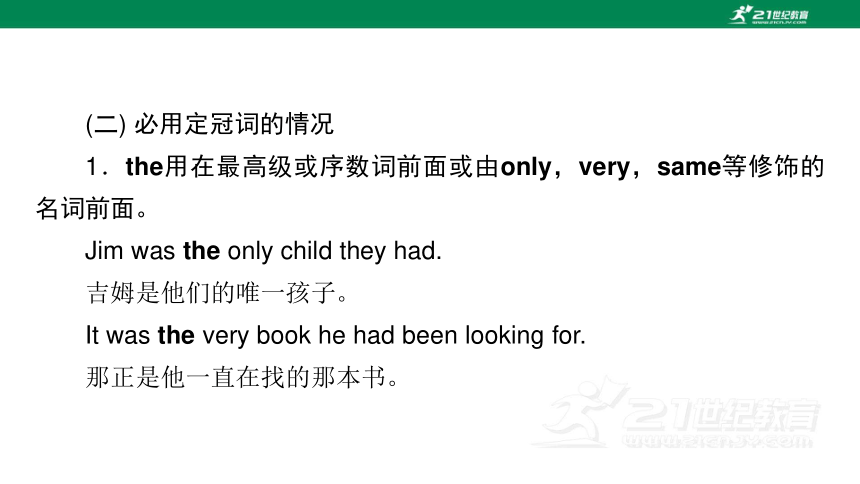
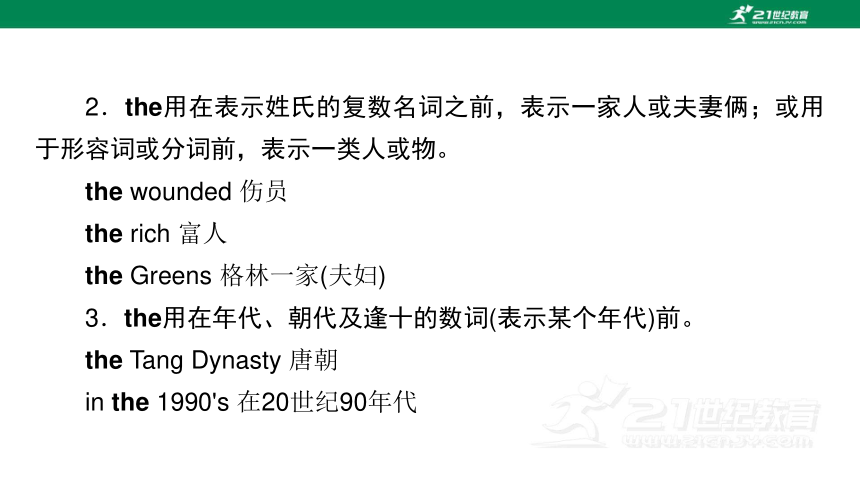
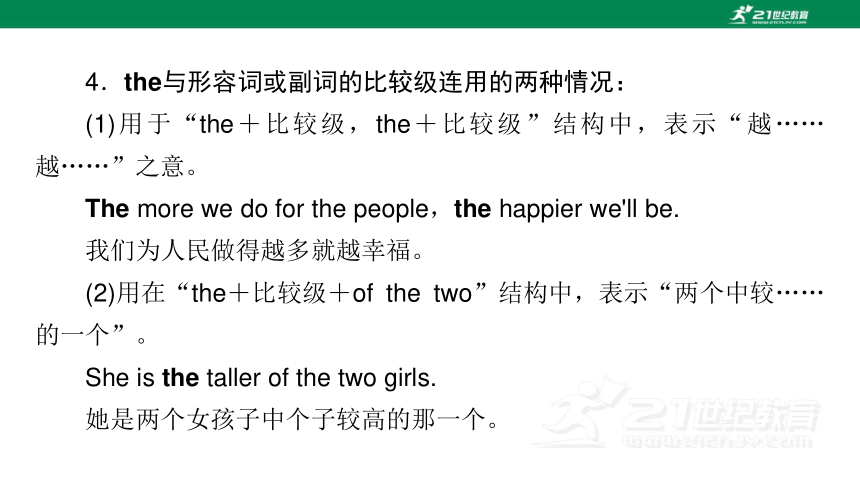
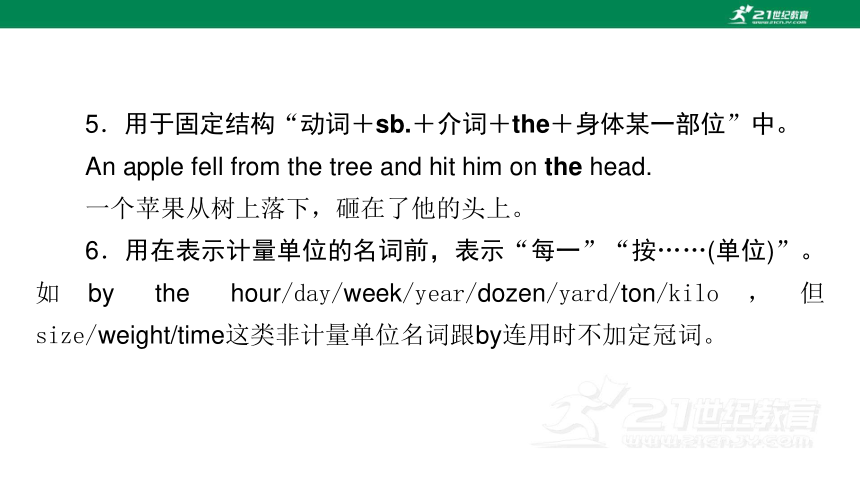
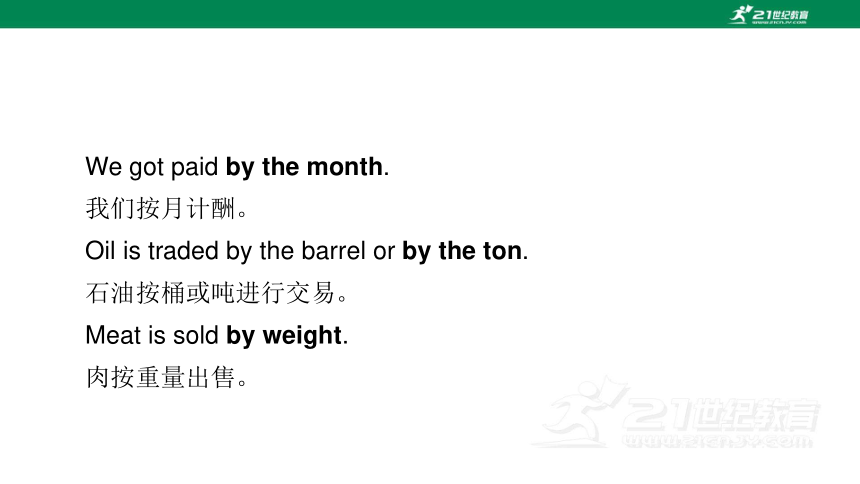
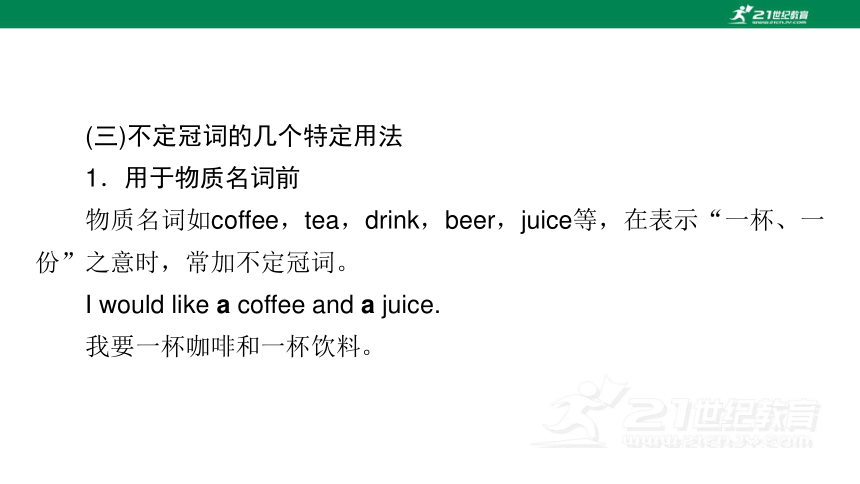
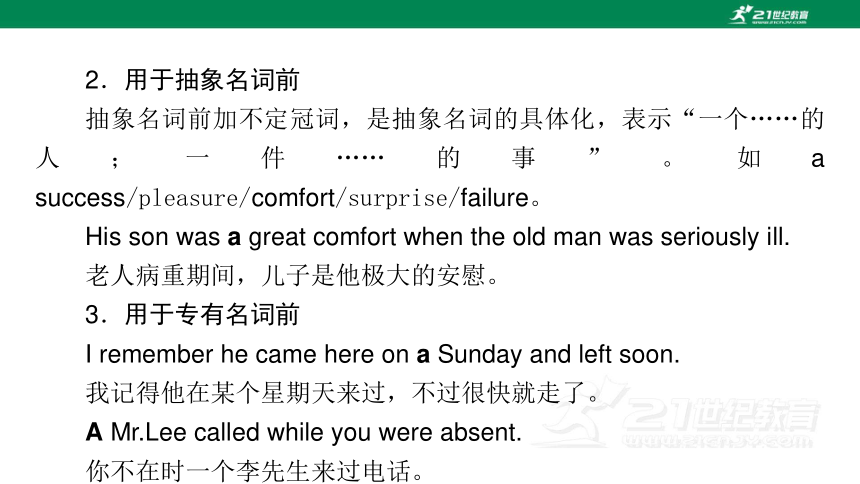
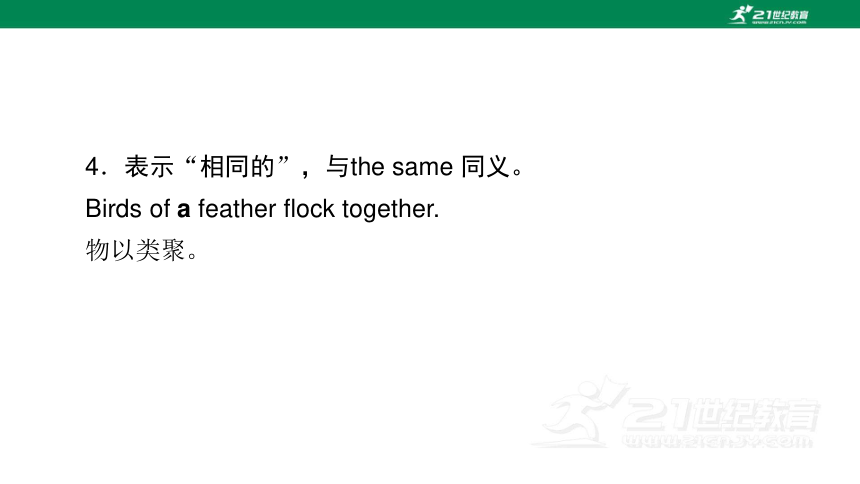


文档简介
(共110张PPT)
专题二 语法填空
※备考指南:语法知识难点、考点集锦
一、 冠词
(一) 冠词的泛指与特指
1.泛指:不定冠词用在首次提到的或不限定的单数可数名词前表泛指。
2.特指:①用在上文提到的人或物前;②用在被限制性修饰语加以限定的人或物前;③用在双方默认的特定的人或物前。
(二) 必用定冠词的情况
1.the用在最高级或序数词前面或由only,very,same等修饰的名词前面。
Jim was the only child they had.
吉姆是他们的唯一孩子。
It was the very book he had been looking for.
那正是他一直在找的那本书。
2.the用在表示姓氏的复数名词之前,表示一家人或夫妻俩;或用于形容词或分词前,表示一类人或物。
the wounded 伤员
the rich 富人
the Greens 格林一家(夫妇)
3.the用在年代、朝代及逢十的数词(表示某个年代)前。
the Tang Dynasty 唐朝
in the 1990's 在20世纪90年代
4.the与形容词或副词的比较级连用的两种情况:
(1)用于“the+比较级,the+比较级”结构中,表示“越……越……”之意。
The more we do for the people,the happier we'll be.
我们为人民做得越多就越幸福。
(2)用在“the+比较级+of the two”结构中,表示“两个中较……的一个”。
She is the taller of the two girls.
她是两个女孩子中个子较高的那一个。
5.用于固定结构“动词+sb.+介词+the+身体某一部位”中。
An apple fell from the tree and hit him on the head.
一个苹果从树上落下,砸在了他的头上。
6.用在表示计量单位的名词前,表示“每一”“按……(单位)”。如by the hour/day/week/year/dozen/yard/ton/kilo,但size/weight/time这类非计量单位名词跟by连用时不加定冠词。
We got paid by the month.
我们按月计酬。
Oil is traded by the barrel or by the ton.
石油按桶或吨进行交易。
Meat is sold by weight.
肉按重量出售。
(三)不定冠词的几个特定用法
1.用于物质名词前
物质名词如coffee,tea,drink,beer,juice等,在表示“一杯、一份”之意时,常加不定冠词。
I would like a coffee and a juice.
我要一杯咖啡和一杯饮料。
2.用于抽象名词前
抽象名词前加不定冠词,是抽象名词的具体化,表示“一个……的人;一件……的事”。如a success/pleasure/comfort/surprise/failure。
His son was a great comfort when the old man was seriously ill.
老人病重期间,儿子是他极大的安慰。
3.用于专有名词前
I remember he came here on a Sunday and left soon.
我记得他在某个星期天来过,不过很快就走了。
A Mr.Lee called while you were absent.
你不在时一个李先生来过电话。
4.表示“相同的”,与the same 同义。
Birds of a feather flock together.
物以类聚。
(四)常考固定搭配
1.含不定冠词的固定搭配
as a result 因此 as a rule 通常
as a whole 总体上 at a loss 不知所措
in a hurry 匆忙 in a word 总之
pay a visit to 拜访 put an end to 结束
once in a while 偶尔 once upon a time 从前
all of a sudden 突然 be on a diet 节食
in a short while 不久 have/catch a cold 感冒
make a living 谋生 have/take a rest 休息
as a matter of fact 事实上 in a sense 在某种意义上
in a way 在某种程度上 keep an eye on 照看,留意
have a gift for 在某方面有天赋 give sb.a lift 让某人搭便车
2.含定冠词的固定搭配
in the end 最后 in the way 挡道
in the distance 在远处 by the way 顺便说一下
on the whole 总的来说 at the same time 同时
to tell the truth 说实话 for the time being 暂时
on the spot 在现场 not in the least 一点也不
the other day 前几天 take the place of 代替
at the moment 此刻,目前 to the point 切题
make the most/best of充分利用 on the other hand 另一方面
in the middle of 在……中间
3.含零冠词的固定搭配
at present 目前 take part in 参加
in peace 平静 by chance/accident 碰巧
on purpose 故意 lose heart 灰心
out of control 失控 out of work 失业
ahead of time 提前 in advance 提前
by law 根据法律 by mistake 由于差错
under repair 处于维修中 day and night 整日整夜
at risk 有危险 in danger 处于危险之中
from morning till night 从早到晚
on second thoughts 再想一想
4.有冠词和没有冠词含义不同的固定搭配
(1)in front of 在……前面(在范围之外)/in the front of 在……前面(在范围之内)
(2)in control of 控制/in the control of被……控制
(3)in charge of 管理/in the charge of受……管理
(4)in word 口头上/in a word 总而言之
(5)take place 发生/take the place of 代替
(6)out of question=beyond question毫无疑问/out of the question=impossible 不可能
(7)by day在白天/by the day 按天计算
(8)in possession of sth.拥有某物/in the possession of sb.为某人所拥有
(9)in place of 代替/in the place of 在……地方
二、谓语动词
(一)根据时间标志词或时间状语确定时态
1.一般现在时:sometimes, every week/day/year/morning, often, always, usually, seldom, now and then。
2.一般过去时:once upon a time, yesterday, last week/month/year, just now, the other day,时间段+ago,时间段+later,in+过去的年份。
3.现在完成时:lately, recently, so/by far, by now, up to now, until now, in/during/over the past/last few+时间段等。in/over recent+时间段,since+过去的时间点,ever since等。
4.现在进行时:Look!Listen!now, at present, at this moment/time/minute, currently。
5.过去进行时:at that moment/time/minute, then。
6.一般将来时:tomorrow, next week/month/year, in (the coming)+时间段,upcoming, in the future。
7.过去完成时:by+过去的时间,by then, by the end of+过去的时间点,until then,before+过去的时间点。
8.将来进行时:at this time/moment tomorrow等。
(二)根据平行结构确定时态
并列连词连接的平行结构,连接对等的词或对等的结构,可以作为时态判断的依据。常见如下:and,but,or,both...and...,either...or...,neither...nor...,not only...but (also)...等。尤其关注一个主语,两个或两个以上的并列谓语,谓语动词的时态要保持一致。
(三)语境提示定时态
如果没有时间标志词或者具体的时间状语,就要联系上下文、前后句中的时态,看看动作是否同时发生或者先后发生,确定填空处的时态。
(四)主句从句相对应
宾语从句中,主句如果用一般过去时,从句也应该用过去的时态;但陈述客观事实或真理时,从句用一般现在时。时间、条件状语从句中,“主将从现”,即主句一般将来,从句用一般现在时表将来。
(五)通过“固定句式”解决时态
1.It/This/That is the first/second/...time that sb./sth.have/has done sth.某人/某物第几次做某事。
2.It/This/That was the first/second/...time that sb./sth.had done sth.某人/某物第几次做某事。
3.hardly/scarcely/rarely...had done...when sb./sth.did...和no sooner...had done...than sb./sth.did...表示“一……就……”。
4.It is (high) time that sb./sth.did/should do...到了某人/某物该做……的时候了。
5....was/were doing...when sb./sth.did...某人/某物正在做……这时突然……
6.祈使句+and+陈述句,陈述句为一般将来时。
7.在时间状语从句或条件状语从句中,如果主句是一般将来时,从句则用一般现在时表示将来。
8.在由since引导的时间状语从句中,如果主句是现在完成时,从句则用一般过去时。
(六)谓语动词的语态
1.如果主语是动作的发出者,要用主动语态;如果主语是动作的承受者,要用被动语态。
2.牢固掌握被动形式
(1)一般现在时:is/am/are done
(2)一般过去时:was/were done
(3)一般将来时:will/shall be done
(4)过去将来时:would be done
(5)现在进行时:is/am/are being done
(6)过去进行时:was/were being done
(7)现在完成时:have/has been done
(8)过去完成时:had been done
(9)将来完成时:will/shall have been done
3.不及物的动词(组)没有被动,如:happen, exist, remain, rise, survive, belong to, break out, break down, come up, come true, take place等。
4.系动词look, seem, feel, taste, sound, smell, prove, appear等不能用被动语态。
(七)主谓一致
所谓主谓一致,就是说在英语中,句子的谓语动词的形式应与句子的主语在人称和数上保持一致。主谓一致主要分为语法一致、意义一致及就近或就远一致,共三种。
1.语法一致
(1)可数名词单数或不可数名词作主语时谓语动词用单数;可数名词复数作主语时谓语动词用复数。
(2)在定语从句中,关系代词that, who, which等作主语时,其谓语动词的数应与句中的先行词的数一致。
(3)单个动名词、不定式、名词性从句作主语时,谓语动词一般用单数。但what引导的主语从句表示复数概念时,谓语动词用复数。
(4)“many a / more than one+单数名词”作主语时,谓语动词用单数。
2.意义一致
(1)集体名词作主语时,若强调整体,则谓语动词用单数;若强调个体,则谓语动词用复数。
常见的集体名词有:family, class, team, group, public, committee, government, audience等。
(2)“分数/百分数/the majority +of +名词”作主语时,谓语动词的单复数取决于of后名词的数及其表示的意义;all, some, half, most, the rest等作主语时,谓语动词的单复数取决于主语实际表达的意义。
(3)“no/each/every/many a+单数名词+and+no/each/every/many a+单数名词”作主语时,谓语动词用单数。
3.就近/就远原则
(1)就近原则:由either...or...,neither...nor...,not...but...,not only...but also...等连接的并列主语或者在there be句型中,谓语动词常与最近的主语在人称和数上保持一致。
(2)就远原则:主语后跟有with, together with, along with, as well as, but, except, rather than, including等引起的短语时,谓语动词的数要与前面的主语保持一致。
(八)情态动词
1.情态动词的基本用法
情态动词不能单独作谓语,必须和后面的实义动词或be动词一起构成谓语。
(1)can/could的用法:
①表示能力,意为“能,会”。
②表示客观或理论上的可能性。
③表示推测,意为“可能”,用于否定句和疑问句。can比could语气强。
(2)may/might的用法:
①表示请求和许可。在疑问句中might可以代替may,语气更加委婉。
②表示推测,意为“或许,可能”,通常用于肯定句和否定句。might比may语气弱。
(3)must的用法:
①表示“必须”,语气强烈。
②表示推测,意为“一定”,用于肯定句。
③意为“偏要,非要……不可”。
(4)shall的用法:
①用于一、三人称疑问句中,表示说话人征求对方的意见。
②用于二、三人称陈述句中,表示说话人的命令、警告、威胁、允诺、决心等;或用于条约、规定、法令、法律等,意为“必须”。
(5)should/ought to的用法:
①should表示责任、义务、劝告、建议等,意为“应该”。
②should表示出乎意料的口气,意为“竟然,居然”。
③should和ought to表示推测,指预期的可能性,意为“应该,估计”。
2.“情态动词 + have done”的用法
该结构主要用来表述过去的情况,包括对过去事情的推测、遗憾、责备等。
(1)must have done “一定做过了某事”,表示对过去事情有把握的推测。
(2)could have done “本来能做某事(而实际上未做)”,
can't/couldn't have done “(过去)不可能做过某事”。
(3)may/might have done “(过去)有可能做过某事”。
(4)should/ought to have done “本该做某事而没做”。
(5)needn't have done “本不必做某事(而实际上做了)”。
(九)虚拟语气
1.虚拟语气在if条件状语从句中的应用
类别 从句谓语动词形式 主句谓语动词
与现在事实相反 一般过去式(be用were) should/would/could/might+动词原形
与过去事实相反 had+过去分词 should/would/could/might+have+过去分词
与将来事实相反 一般过去式(be用were) should/would/could/might+动词原形
should+动词原形
were to+动词原形
类别 从句谓语动词形式 主句谓语动词
混合条
件句 有时条件句的动作与主句的动作发生的时间不一致,这时动词的形式应根据它们各自发生的时间作相应调整。
含蓄条
件句 有时假设的情况不以条件从句的形式表达,而是用but for,without等介词短语表示虚拟条件。
虚实错
综句 (1)用otherwise,or 等暗示后文与前面的情况相反,从而引出后文的虚拟语气。
(2)通过but 暗示出虚拟条件,句式结构为“虚拟情况+but+真实情况”。
2.虚拟语气在其他从句中的应用
(1)wish后面的宾语从句,表示一种不可能实现的愿望:
①表示与现在事实相反,从句谓语动词用过去式。
②表示与过去事实相反,从句用had+done。
③表示与将来事实相反,从句用would/could/should/might+动词原形。
(2)would rather后面的宾语从句:
①表示与现在或将来事实相反时,从句谓语动词用过去式。
②表示与过去事实相反时,从句用had+done。
(3)表示主张、命令、建议、要求等词后的宾语从句、表语从句和同位语从句中常用“should+动词原形”结构,should可省略。
(4)定语从句:
It's high/about time (that) ...句型中,从句的谓语动词用一般过去时或should+动词原形(其中should不可省略),意为“到了该……的时候了”。
(5)as if引导的状语从句中:
①表示与现在事实相反,谓语动词用过去式。
②表示与过去事实相反,谓语动词用had+done。
③表示与将来事实相反,谓语动词用would/could/might+动词原形。
(6)在“It is important/necessary/natural/strange that ...”句型中,that引导的主语从句中谓语动词常用“(should)+动词原形”形式。
三、非谓语动词
(一)非谓语动词在句中可作主语、宾语、表语、状语、定语、补语多种成分,掌握非谓语动词的句法功能,判断出其应作哪种成分是解题的关键。
1.作伴随状语和结果状语时用现在分词
More highways have been built in China,making it much easier for people to travel from one place to another.
中国又建了更多的高速公路,这使人们从一处到另一处的出行变得更容易了。(表结果)
All night long he lay awake,thinking of the problem.
他整夜躺在床上睡不着,思考着那个问题。(表伴随)
【特别提醒】 源于系表结构的部分过去分词作状语,表示句子主语所处的一种状态,常见的有:seated (坐着的),devoted (专注的),lost/absorbed in (沉溺于),dressed in (穿着)等。
Absorbed in his book, he didn't notice me enter the room.
他专注读书,没注意到我进入房间。
2.作目的状语时用不定式,且只能用不定式的一般式
(1)非谓语动词作目的状语,一般用不定式。
To make it easier to get in touch with us,you'd better keep this card at hand.
为了更容易与我们取得联系,你最好随身带着这张卡片。
(2)非谓语动词作结果状语,表示出乎意料的结果要用不定式,表示必然的结果要用现在分词。
He hurried to the station, only to find that the train had left.
他匆匆赶到车站结果却发现火车已经离开了。(表出乎意料的结果)
(3)非谓语动词作原因状语,在表示“喜怒哀乐”的形容词之后用不定式;非谓语动词作时间状语、条件状语和原因状语等用分词。
I am only too glad to see everything settled.
看到一切问题都解决了,我很高兴。
Being tired, he went to bed early.
因为很累,他很早就睡了。
3.作主语时常用动名词,作介词的宾语时一定用动名词
(1)分析句子成分,如果一个经常性、习惯性的动作作主语,常用v.-ing形式。
Knowing basic first-aid techniques will help you respond quickly to emergencies.
掌握基本的急救技能将有助于你在遇到紧急情况时迅速做出反应。
(2)介词和带介词to的固定搭配一定跟v.-ing作宾语。
I'm looking forward to hearing from you as soon as possible.
我希望尽快收到你的来信。
4.作表语时指物用v.-ing,指人用v.-ed形式
●牢记v.-ing作表语或定语时常指物,v.-ed作表语或定语时常指人。
He was very shocked to learn the shocking news that his wife was killed in a traffic accident.
得知他的妻子在交通事故中死亡这一令人震惊的消息时,他非常吃惊。
(二)非谓语动词各形式的意义
非谓语动词形式 意义
过去分词done 表示被动、完成
现在分词主动式doing 表示主动、进行
现在分词的被动式being done 表示被动、进行
不定式的主动式to do 表示主动且尚未发生
不定式的被动式to be done 表示被动且尚未发生
非谓语动词的完成式 非谓语动作发生在谓语动作之前
We are invited to a party to be held in our club next Friday.
我们被邀请参加下星期五在我们俱乐部举办的晚会。
Having been told many times,he still couldn't understand it.
被告知了多次,他仍旧不明白。
(三)非谓语动词的习惯用法
1.用v.-ing/to do形式作宾语的词(短语)
(1)接v.-ing形式作宾语的常用动词(短语)有:suggest,risk,imagine,mind,admit,practice,allow,avoid,delay,include,deny,escape,advise,finish,miss,forgive,consider,recommend,forbid,give up,insist on,look forward to,feel like,get down to,object to,devote...to,pay attention to等。
I avoided mentioning the subject in case he should be offended.
我回避提及这个话题,以免冒犯他。
(2)接to do形式作宾语的常用动词(短语)有:decide,refuse,promise,pretend,hesitate,manage,plan,fail,choose,desire,hope,afford,agree,learn,determine,demand,offer,make up one's mind,would like等。
Nervous and anxious,Jill failed to make a good impression at the job interview.
又紧张又焦虑,吉尔没有在面试中给人留下好印象。
(3)有些动词或动词短语既可接不定式作宾语,也可接动名词作宾语,但表示的含义不同。
I regret to tell you that he didn't take your application into consideration.
我很遗憾地告诉你他没有考虑你的申请。
I regret making rude comments on your appearance.
我很后悔对你的外表做了粗鲁的评论。
2.非谓语动词的几种句型
(1)不定式作宾语补足语
tell/order/persuade/force/warn/encourage/ask/invite+sb.to do sth.
I'd like to invite you to take part in the activity.
我想邀请你参加这项活动。
(2)用省略“to”的不定式作宾语补足语的动词:“五看;三使;二听;一感觉”。
五看:look at/watch/notice/see/observe sb.do sth.;
三使:make/have/let sb.do sth.;
二听:listen to/hear sb.do sth.;
一感觉:feel sb.do sth.。
The boss made the workers do the work all day.
老板迫使工人们整天干活。
(3)用于it形式主语结构中
It+be+名词或形容词(no good/no use/a pleasure/worthwhile/useless)+动词-ing;
It+be+形容词(difficult/kind/clever等)+for/of sb.to do sth.;
It+takes+sb.+some time+to do sth.
As is known to us, it's no use complaining without taking action.
众所周知,只抱怨不采取行动没用。
3.with复合结构中补足语的比较
With so many people looking at him,he felt very nervous.
那么多人看着他,他感到很紧张。
With the problem solved,the quality has been improved.
问题解决了,质量也提高了。
4.to为介词后接doing的短语
be/get/become used to 习惯于
be accustomed to 习惯于
be addicted to 沉溺于;对……上瘾
be opposed to 反对
object to 反对
devote oneself to 献身于;专心于
be devoted to 致力于;忠诚于
be admitted to 被……录取;准许进入
lead to 导致
contribute to 贡献;导致;促进
look forward to 期待
stick to 坚持
be equal to 胜任
have access to 有接近(某物的)方法
attach great importance to 重视
get down to 开始
the key/approach to ……的关键/方法
when it comes to 当谈到
5.用不定式to do的结构
①enough to do sth.足够(……)去做某事
②be likely to do sth.很可能做某事
③too...to...太……而不能……
④be used to do sth.被用来做某事
⑤be designed to do sth.被设计用来做某事
⑥be intended to do sth.打算做某事
⑦tend to do sth. 倾向于做某事
⑧be to blame 应受责备(无被动)
⑨aim to do sth.旨在做某事
⑩be eager to do sth.渴望做某事
the first/last(序数词) to do sth.第一个/最后一个做某事的人
the aim/ability/chance/opportunity/plan/promise/purpose/ambition/ goal/target to do sth.做某事的目的/能力/机会/计划/承诺/目的/雄心/目标
can't/can hardly wait to do sth.迫不及待做某事
There is no need to do sth.没有必要做某事。
It takes sb.some time to do sth.某人花多少时间做某事。
sb./sth.be said/supposed/believed/thought/known/reported to do/to be done/to have done据说/认为/报道某人/某物……
it remains to be seen...尚待分晓;拭目以待
主语+be+adj.+to do 句型
适用于此结构的形容词有:easy, hard, difficult, important, impossible, interesting, pleasant, nice, comfortable, safe, dangerous等。
6.用动名词v.-ing的结构
①be (well) worth doing 某事(很)值得做
②can't help doing sth.情不自禁做某事
③have fun doing sth.做某事很开心
④feel like doing sth.想做某事
⑤get used to doing sth.习惯于做某事
⑥It's no use/good/pleasure (in) doing sth.做某事没有用处/好处/乐趣。
⑦have difficulty/trouble (in) doing sth.做某事有困难
⑧have a difficult/hard time (in) doing sth.做某事有困难
⑨be busy (in) doing sth.忙于做某事
⑩spend money/time (in) doing sth.花费金钱或时间做某事
prevent/stop...(from) doing sth.阻止……做某事
aim at doing sth.旨在做某事
succeed (in) doing sth.成功地做成了某事
There is no sense/point (in) doing sth.做某事没有意义。
7.一些非谓语动词形式的固定结构
considering that 鉴于,考虑到
judging by/from 从……来判断
supposing/providing/provided/assuming that...假定,假设
compared with/to 与……相比
Michael's new house is like a huge palace,compared with his old one.
与迈克尔的旧房子比起来,他的新房子像个大宫殿。
四、并列句和复合句
(一)并列句
1.并列连词的基本含义
并列
连词 并列关系或递进关系 and,when(=and just at that time),both...and...,not only...but also...
转折或对比关系 but,while(而,表示对比),yet,not...but...
选择关系 or,otherwise,or else(否则,要不然),either...or...,neither...nor...
因果关系 for,so
2.并列连词不能和从属连词同时使用。如果出现although/though,后面就不能用but;如果出现because,后面就不能用so。
3.祈使句+and/or+陈述句。
4.与并列连词when相关的句式归纳
(1) be (just) about to do...when...
She was just about to say something more when she noticed the sullen look on his face.
她刚要再说些什么,却突然看到了他阴沉的脸色。
(2)be (just) on the point of doing sth....when...
They were on the point of giving up when the captain encouraged them fiercely to save the ship.
就在他们快要放弃努力时,船长鼓励他们竭尽全力挽救轮船。
(3)be going to do...when...
He was going to run away when the policemen came.
他正打算逃跑,警察突然出现了。
(4)be doing sth....when...
The children were playing football on the playground when it began to rain.
孩子们正在操场上踢足球,突然下起了大雨。
(5)be busy doing...when...
I was busy doing my homework when one of my classmates came.
我正忙着做作业,这时我的一个同学来找我。
(6) had (just) done...when...
I had just gone to bed after a very hard day when the phone rang.
在劳累了一天之后,我刚上床睡觉,这时电话响了。
(7) had not done...when...
I hadn't walked a few steps when I realized that he asked for the direction to my office building.
我还没走出去几步远,突然意识到他问的是去办公大楼的方向。
(8) be+介词短语+when...
He was on his way to a lecture when a tourist stopped him and asked him for directions.
在他去听课的路上,一名游客拦住他问路。
(二)状语从句
1.判断依据
状语从句是用来描述动作发生时的各方面情况,通过语境判断上下文的逻辑关系是时间、地点、条件、原因、让步、目的或其他,最后确定从属连词。
2.高频状语从句引导词
状
语
从
句 时间状语 when,while,as,before,after,once,till,until,since,every time,the moment,hardly...when
地点状语 where,wherever(无论什么地方,不管哪里)
原因状语 because,since,as,now that(=since既然,由于)
状语
从句 目的状语 so that(为了,以便),in order that,in case(以防万一)
结果状语 so that(结果),so...that,such...that(如此……以至于)
条件
状语 if,unless(除非,如果不),as long as(只要),so long as(只要),on condition that(条件是),in case(如果,万一)
方式状语 as(像,依照),as if/as though(好像,仿佛)
让步
状语 although,though,as(状语或表语要提到as前,作表语的单数可数名词提前时,不用a或an),even if/even though(即使),whether...or...(不管……还是……),whoever(=no matter who),whatever(=no matter what),whenever(=no matter when),whichever(=no matter which)
比较
状语 than,as...as...,not as...as...,not so...as...,the same...as...,such...as...,the more...the more...
3.as表示“尽管”,引导让步状语从句时,需要把表语前置到句首。作表语的名词前置时,有冠词的要去掉冠词。
Difficult as it may be=Although/Though it may be difficult
Silent student as he is =Although/Though he is a silent student
4.while引导的让步状语从句,只能位于主句之前(在句首)。
While the work was difficult, it was interesting.
虽然工作有难度,但很有趣。
While I understand what you say,I can't agree with you.
虽然我理解你的意思,但我还是不能同意。
(三)定语从句
1.在定语从句中,应根据从句的先行词和关系词在从句中作什么句子成分来确定关系词。
若在从句中作主语、宾语、表语和定语,就用关系代词;若作状语,就用关系副词。
2.三步确定关系词
Step 1 逗号判断限制非限制
先行词后面出现逗号,是非限制性定语从句,此时用who指代指人的先行词,用which指代指物的先行词,也可以代替主句整句话。
Step 2 找到先行词,判断是人是物
①先行词是人:that/who/whom/whose
②先行词是物:that/which/whose
③先行词是时间/地点/原因:when/where/why
Step 3 根据从句即设空处后面缺少的成分,确定最后答案
①缺主语:that/which/who
②缺及物动词的宾语:that/which/who/whom
③缺介词的宾语:which/whom
④缺定语:whose(和先行词构成所属关系)
⑤缺时间/地点/原因状语:when/where/why
3.非限制性定语从句中as和which的区别
as和which均可用来引导非限制性定语从句,指代主句的内容,但as可位于句首,而which常位于句中;as常用于肯定句,而which可用于否定句。此外,as译作“正如,正像”,而which译作“这,这一点”。
The mother tried to persuade her son to give up smoking, which didn't help.
母亲竭力劝说儿子戒烟,但没有作用。
As the old saying goes,“You can't judge a book by its cover.”
正如谚语所言:“人不可貌相。”
4.stage/point/case/situation/scene/degree等抽象意义的地点名词作先行词时,若从句成分完整则用where,若从句缺少主宾成分,则用that/which。
5.下列情况只用that不用which
(1)当先行词是all,any,anything,everything,nothing等不定代词或被它们修饰时;
(2)当先行词被形容词的最高级或序数词修饰时;
(3)当先行词被the only,the very,the just,the same等修饰时;
(4)当先行词既有人又有物时。
(四)名词性从句
1.名词性从句的位置
①主语从句往往位于句首,或者it作形式主语位于句首。
②宾语从句位于及物动词或者介词之后。
③表语从句位于系动词之后。
④同位语从句位于抽象意义的名词之后,如:fact,idea,news,truth,hope,doubt,suggestion,belief,evidence等,说明抽象名词的内容。
2.分析从句缺少成分,判断常见引导词
①缺少主宾表,就用连接代词what/who/whom/which或者whatever/whoever/whomever/whichever。
②缺少状语,就用连接副词where/wherever(地点),when/whenever(时间),how/however(方式),why(原因)。
③不缺少成分,就要考虑句子意思是否完整,是否需要用whether/if。
④不缺少成分,且意思完整,则用that。
3.高频重难点:that 与what 的用法区别
①what 在从句中起双重作用:既引导该名词性从句,又在从句中充当主、宾、表、定语成分。
It is uncertain what side effect the medicine will bring about, although about two thousand patients have taken it.
目前尚不清楚这种药会带来什么副作用,尽管大约有两千名病人服用了它。
②that引导名词性从句,没有含义,不充当成分。但是只在引导第一个宾语从句时可以省略。that引导主语从句、表语从句、同位语从句或第二个宾语从句时不可以省略。
4.重点句型
What...is that...
what引导主语从句,that引导表语从句。
What is the most important is that every one should be present in time.
最重要的是每个人都要及时到场。
五、特殊句式
(一)祈使句
1.祈使句表示请求、命令、建议等,谓语动词一律用原形。句子通常不用主语,句末用惊叹号或句号,读时用降调。
2.有时,为了加强语气,可以在动词之前加do。
Do study hard.
一定要努力学习。
3.祈使句中可以有称呼语,一定要用逗号隔开,放在句首或句末。
Jim, come here.=Come here,Jim.
吉姆,过来。
4.祈使句+and/or+陈述句
Study hard, and you'll make great progress.
努力学习,你就会取得很大的进步。
Follow your doctor's advice, or your cough will get worse.
听从医生的建议,否则你的咳嗽会更严重。
(二)感叹句
记准what+名词或名词词组,how+adj./adv.
1.What+a/an+adj.+单数可数名词+主语+谓语(系动词)!
2.What+adj.+复数或不可数名词+主语+谓语(系动词)!
3.How+adj.+a/an+单数可数名词+主语+谓语(系动词)!
4.How+adj./adv.+主语+谓语(系动词)!
(三)省略句
1.状语从句中的省略
由when,while,as,until,once,where,if,unless,as if,although/though,whether等引导的时间、地点、条件、方式或让步等状语从句中,如果从句的谓语含有be动词,且从句的主语是it或主从句的主语相同时,此时可省略从句的主语和be动词。
The experiment shows that proper amounts of exercise, if carried out regularly,can improve our health.
实验表明,如果进行得有规律,适量的运动能强身健体。
2.常用的省略结构
if ever 如果有过的话
if busy 如果忙的话
if any 如果有一些的话
if possible 如果可能的话
if so 如果那样的话
if not 如果不的话
3.动词不定式的省略
(1)在动词不定式结构中,为避免重复,常常省略不定式结构中的动词原形,只保留to。
—Would you like to go with us
—I'm glad to, but I have to finish my homework.
——你愿意和我们一起去吗?
——我很愿意去,但我不得不先写完作业。
(2)tell,warn,order,advise,ask等动词的宾语后接动词不定式作宾语补足语时,可以省略to后的动词原形。
The boy wanted to play football in the street, but his mother told him not to.
这个男孩想要在街上踢足球,但他妈妈告诉他不要如此。
4.用so或not等替代上文内容的省略
当由I'm afraid,I think,I believe,I hope,I guess等作答语时,后面的so与not分别表示肯定和否定,宾语从句可省略。
Maybe I will be proven wrong, but I hope not.
也许我会被证明是错的,但我希望不是那样。
(四)强调句
1.强调句型基本结构及注意事项
强调句型基本结构为“It+is/was+被强调部分+that/who+句子其他部分”,在理解强调句时,考生要注意以下几点:
(1)强调句型可强调的句子成分通常为主语、状语、宾语等,不能用来强调谓语动词(如强调谓语动词,常借助于do/does/did)、表语、主语补语、让步状语、条件状语等。连接词一般用that,如被强调的部分指人时,可用who/that,其他一律用that。
(2)判断是否是强调句,就是看把句子中的“It is/was和that/who”去掉之后,句子是否成立。若句子依然成立,则是强调句,否则就不是强调句。
(3)强调句的一般疑问句结构:Is/Was+it+被强调部分+that/who+其他部分?
(4)强调句的特殊疑问句结构:特殊疑问词+is/was+it+that+其他部分?
(5)not...until...的强调句型:It is/was not until+被强调部分+that/who+其他部分。
It is not how much we do but how much love we put into what we do that benefits our work most.
给我们工作带来最大益处的不是我们做了多少而是我们将多少爱投入到我们所从事的事业中。
Was it in 1939 that the Second World War broke out
第二次世界大战是在1939年爆发的吗?
When was it that you called me yesterday
你昨天是什么时候给我打电话的?
2.强调句型与结构相似的主从复合句的区别
(1)与含主语从句的主从复合句的区别
It is true that they are going to visit the Great Wall next month.
他们下个月准备去参观长城,这是真的。
It is the Great Wall that they are going to visit.
他们打算去参观的地方是长城。
第一个句子是一个主从复合句,其中it是形式主语;that引导的是主语从句,that没有任何意义,在从句中不作任何成分。第二个句子是强调句,强调的是宾语the Great wall,It is和that没有任何意义,只是用来构成强调句型的基本框架。
(2)与含定语从句的主从复合句的区别
It is a question that needs careful consideration.
这是一个需要仔细考虑的问题。
It is novels that William enjoys reading.
威廉喜欢读的是小说。
第一个句子是一个主从复合句,其中that引导的是定语从句,修饰先行词question,that在从句中作主语;It在主句中作主语。第二个句子是强调句,强调的是宾语novels,It is和that没有任何意义,只是用来构成强调句型的基本框架。
(3)与含状语从句的主从复合句的区别
①与“It is/was+时间名词+when...”的区别
“It is/was+时间名词+when...”句型中,it指时间,when引导的是时间状语从句。时间名词前无介词。
It was 6 o'clock when I got up today.
今天我起床时已经6点了。
It was at 6 o'clock that I got up today.
今天我是6点起的床。
第一句是主从复合句,It指时刻,when引导时间状语从句。第二句是强调句型,强调的是时间状语at 6 o'clock,It was和that无实际意义,去掉后句子依然成立。
②与“It is/was+时间段+since...”的区别
“It is/was+时间段+since ...”句型中,since引导时间状语从句。若since和延续性动词连用,该句型的意思是“……不做某事已有……时间了”;若since和短暂性动词连用,该句型的意思是“……做某事已有……时间了”。since引导的从句常用一般过去时。
It is two years since I taught English.
我不教英语两年了。
It is two years since I began to teach English.
我教英语已经两年了。
It is two hours that he spends on English every day.
他每天花两个小时学英语。
前两个句子是“It is+时间段+since ...”句型,since引导时间状语从句。第三个句子是强调句,强调的是宾语two hours。
③与“It was/will be+时间段+before ...”的区别
“It was/will be+时间段+before ...”句型中,it指时间,before引导时间状语从句。
It was two years before he came back from abroad.
过了两年他才回国。
It was two years later that he came back from abroad.
他是两年后回国的。
第一句中的It指时间,before引导的是时间状语从句;第二句为强调句,强调的是时间状语two years later。
(五)倒装句
倒装是高考考查的常考点,而且常把倒装与时态、主谓一致等结合在一起进行考查,增加了考查的难度,因此考生一定要把倒装的基本用法牢记在心。倒装分为完全倒装与部分倒装。
1.完全倒装
当作状语的here,there,now,then,down,up,out,off等表示地点、时间或方位的副词或表示地点的介词短语置于句首且主语为名词时,句子要完全倒装。但当主语是代词时,主谓不倒装。
John opened the door.There stood a girl he had never seen before.
约翰打开门,他从来没见过的一位女孩站在那儿。
South of the river lies a small factory.
河的南面有一个小工厂。
Here he comes!
他来了!
2.部分倒装
(1)only修饰副词、介词短语或状语从句置于句首时,主句要用部分倒装。
Only in this way can we learn English well.
只有以这种方法,我们才能学好英语。
(2)否定副词never,nor,not,hardly,little,seldom,scarcely,rarely等及表否定意义的介词短语at no time,under/in no circumstances,in no case,by no means,on no condition等置于句首时要部分倒装。
Never before have I seen such a moving film.
以前我从未看过这么感人的电影。
(3)表示前面所说的情况也适用于后者时,用部分倒装结构so/neither/nor+助动词/系动词/情态动词+主语。
They love having lots of friends;so do those with disabilities.
他们喜欢交很多朋友,那些有残疾的人也是如此。
(4)So+adj./adv....that .../Such+(a/an)+adj.+n....+that ...“如此……以至于……”。
So cold was the weather that we had to stay at home.
天气太冷,我们只好待在家里。
(5)Not only...but also...“不仅……而且……”,Not only后是主谓倒装,but also后是正常语序。
Not only will help be given to people to find jobs,but medical treatment will be provided for people who need it.
不仅要给那些找工作的人提供帮助,而且也要给那些需要帮助的人提供医疗保健服务。
(6)在as/though引导的让步状语从句中,从句的表语/状语/动词位于句首,构成部分倒装结构。如果位于句首的是单数可数名词,其前不加冠词。
Child as he is, he knows a lot about the history of China.
尽管他是个孩子,但他对中国历史知道很多。
(7)在非真实条件句中,条件句中的if省略时,助动词had,were,should常提到主语前面,构成部分倒装。
Were I a teacher, I would be strict with my students.
=If I were a teacher,I would be strict with my students.
如果我是老师,我会严格要求我的学生的。
(六)there be句式
there be句型是高考考查的重点语法项目,近年来高考均考查其最基本的用法,因此考生只需要掌握以下基本用法即可。
1.there be句型中的be可以有不同的时态,可以和助动词或情态动词连用。
There have been many great changes in our country since then.
自从那时起我们国家发生了很多巨变。
2.there be句型的衍生结构
be可以用seem to be, appear to be, happen to be, used to be, have to be, remain, lie等替换。
There seems to be an announcement about the project.
关于这个项目似乎有一个通知。
There remains some confusion about the nature of online teaching.
人们对于在线教育的性质还存在一些疑惑。
3.there be句型的主谓一致
如果主语由两个或两个以上的名词或代词构成,谓语动词be应和离它最近的主语保持一致。
There is a knife and two pens in the pocket.
他的口袋里有一把小刀和两支钢笔。
4.there be句型的常用结构
There is no doubt that...毫无疑问……
There is no need to do...没有必要做……
There is no denying that...不可否认……
There is no point/sense in doing sth.做某事没有意义。
There is (no) difficulty in doing sth.做某事(没)有困难。
There is (no) possibility of (doing) sth./that...(做)某事(没)有可能性。
5.there be句型的非限定形式(there being和there to be)
(1)there being是一个独立主格结构,可在句中作状语,表原因。
There being no evidence against him,Frank is unlikely to be convicted.(=Because there is no evidence against him...)
由于没有不利于他的证据,Frank不可能被判有罪。
there being也相当于一个带有逻辑主语的动词-ing形式。在句子中可作介词(除介词for外) 的宾语。
Judging from there being no much furniture in the house, we know that they are very poor.
从他家没有什么家具来看,我们知道他们很穷。
(2)there to be可以用作动词的宾语,表示一种尚未实现的愿望。
I expect there to be no argument about this.
我期望关于这件事没有争吵。
专题二 语法填空
※备考指南:语法知识难点、考点集锦
一、 冠词
(一) 冠词的泛指与特指
1.泛指:不定冠词用在首次提到的或不限定的单数可数名词前表泛指。
2.特指:①用在上文提到的人或物前;②用在被限制性修饰语加以限定的人或物前;③用在双方默认的特定的人或物前。
(二) 必用定冠词的情况
1.the用在最高级或序数词前面或由only,very,same等修饰的名词前面。
Jim was the only child they had.
吉姆是他们的唯一孩子。
It was the very book he had been looking for.
那正是他一直在找的那本书。
2.the用在表示姓氏的复数名词之前,表示一家人或夫妻俩;或用于形容词或分词前,表示一类人或物。
the wounded 伤员
the rich 富人
the Greens 格林一家(夫妇)
3.the用在年代、朝代及逢十的数词(表示某个年代)前。
the Tang Dynasty 唐朝
in the 1990's 在20世纪90年代
4.the与形容词或副词的比较级连用的两种情况:
(1)用于“the+比较级,the+比较级”结构中,表示“越……越……”之意。
The more we do for the people,the happier we'll be.
我们为人民做得越多就越幸福。
(2)用在“the+比较级+of the two”结构中,表示“两个中较……的一个”。
She is the taller of the two girls.
她是两个女孩子中个子较高的那一个。
5.用于固定结构“动词+sb.+介词+the+身体某一部位”中。
An apple fell from the tree and hit him on the head.
一个苹果从树上落下,砸在了他的头上。
6.用在表示计量单位的名词前,表示“每一”“按……(单位)”。如by the hour/day/week/year/dozen/yard/ton/kilo,但size/weight/time这类非计量单位名词跟by连用时不加定冠词。
We got paid by the month.
我们按月计酬。
Oil is traded by the barrel or by the ton.
石油按桶或吨进行交易。
Meat is sold by weight.
肉按重量出售。
(三)不定冠词的几个特定用法
1.用于物质名词前
物质名词如coffee,tea,drink,beer,juice等,在表示“一杯、一份”之意时,常加不定冠词。
I would like a coffee and a juice.
我要一杯咖啡和一杯饮料。
2.用于抽象名词前
抽象名词前加不定冠词,是抽象名词的具体化,表示“一个……的人;一件……的事”。如a success/pleasure/comfort/surprise/failure。
His son was a great comfort when the old man was seriously ill.
老人病重期间,儿子是他极大的安慰。
3.用于专有名词前
I remember he came here on a Sunday and left soon.
我记得他在某个星期天来过,不过很快就走了。
A Mr.Lee called while you were absent.
你不在时一个李先生来过电话。
4.表示“相同的”,与the same 同义。
Birds of a feather flock together.
物以类聚。
(四)常考固定搭配
1.含不定冠词的固定搭配
as a result 因此 as a rule 通常
as a whole 总体上 at a loss 不知所措
in a hurry 匆忙 in a word 总之
pay a visit to 拜访 put an end to 结束
once in a while 偶尔 once upon a time 从前
all of a sudden 突然 be on a diet 节食
in a short while 不久 have/catch a cold 感冒
make a living 谋生 have/take a rest 休息
as a matter of fact 事实上 in a sense 在某种意义上
in a way 在某种程度上 keep an eye on 照看,留意
have a gift for 在某方面有天赋 give sb.a lift 让某人搭便车
2.含定冠词的固定搭配
in the end 最后 in the way 挡道
in the distance 在远处 by the way 顺便说一下
on the whole 总的来说 at the same time 同时
to tell the truth 说实话 for the time being 暂时
on the spot 在现场 not in the least 一点也不
the other day 前几天 take the place of 代替
at the moment 此刻,目前 to the point 切题
make the most/best of充分利用 on the other hand 另一方面
in the middle of 在……中间
3.含零冠词的固定搭配
at present 目前 take part in 参加
in peace 平静 by chance/accident 碰巧
on purpose 故意 lose heart 灰心
out of control 失控 out of work 失业
ahead of time 提前 in advance 提前
by law 根据法律 by mistake 由于差错
under repair 处于维修中 day and night 整日整夜
at risk 有危险 in danger 处于危险之中
from morning till night 从早到晚
on second thoughts 再想一想
4.有冠词和没有冠词含义不同的固定搭配
(1)in front of 在……前面(在范围之外)/in the front of 在……前面(在范围之内)
(2)in control of 控制/in the control of被……控制
(3)in charge of 管理/in the charge of受……管理
(4)in word 口头上/in a word 总而言之
(5)take place 发生/take the place of 代替
(6)out of question=beyond question毫无疑问/out of the question=impossible 不可能
(7)by day在白天/by the day 按天计算
(8)in possession of sth.拥有某物/in the possession of sb.为某人所拥有
(9)in place of 代替/in the place of 在……地方
二、谓语动词
(一)根据时间标志词或时间状语确定时态
1.一般现在时:sometimes, every week/day/year/morning, often, always, usually, seldom, now and then。
2.一般过去时:once upon a time, yesterday, last week/month/year, just now, the other day,时间段+ago,时间段+later,in+过去的年份。
3.现在完成时:lately, recently, so/by far, by now, up to now, until now, in/during/over the past/last few+时间段等。in/over recent+时间段,since+过去的时间点,ever since等。
4.现在进行时:Look!Listen!now, at present, at this moment/time/minute, currently。
5.过去进行时:at that moment/time/minute, then。
6.一般将来时:tomorrow, next week/month/year, in (the coming)+时间段,upcoming, in the future。
7.过去完成时:by+过去的时间,by then, by the end of+过去的时间点,until then,before+过去的时间点。
8.将来进行时:at this time/moment tomorrow等。
(二)根据平行结构确定时态
并列连词连接的平行结构,连接对等的词或对等的结构,可以作为时态判断的依据。常见如下:and,but,or,both...and...,either...or...,neither...nor...,not only...but (also)...等。尤其关注一个主语,两个或两个以上的并列谓语,谓语动词的时态要保持一致。
(三)语境提示定时态
如果没有时间标志词或者具体的时间状语,就要联系上下文、前后句中的时态,看看动作是否同时发生或者先后发生,确定填空处的时态。
(四)主句从句相对应
宾语从句中,主句如果用一般过去时,从句也应该用过去的时态;但陈述客观事实或真理时,从句用一般现在时。时间、条件状语从句中,“主将从现”,即主句一般将来,从句用一般现在时表将来。
(五)通过“固定句式”解决时态
1.It/This/That is the first/second/...time that sb./sth.have/has done sth.某人/某物第几次做某事。
2.It/This/That was the first/second/...time that sb./sth.had done sth.某人/某物第几次做某事。
3.hardly/scarcely/rarely...had done...when sb./sth.did...和no sooner...had done...than sb./sth.did...表示“一……就……”。
4.It is (high) time that sb./sth.did/should do...到了某人/某物该做……的时候了。
5....was/were doing...when sb./sth.did...某人/某物正在做……这时突然……
6.祈使句+and+陈述句,陈述句为一般将来时。
7.在时间状语从句或条件状语从句中,如果主句是一般将来时,从句则用一般现在时表示将来。
8.在由since引导的时间状语从句中,如果主句是现在完成时,从句则用一般过去时。
(六)谓语动词的语态
1.如果主语是动作的发出者,要用主动语态;如果主语是动作的承受者,要用被动语态。
2.牢固掌握被动形式
(1)一般现在时:is/am/are done
(2)一般过去时:was/were done
(3)一般将来时:will/shall be done
(4)过去将来时:would be done
(5)现在进行时:is/am/are being done
(6)过去进行时:was/were being done
(7)现在完成时:have/has been done
(8)过去完成时:had been done
(9)将来完成时:will/shall have been done
3.不及物的动词(组)没有被动,如:happen, exist, remain, rise, survive, belong to, break out, break down, come up, come true, take place等。
4.系动词look, seem, feel, taste, sound, smell, prove, appear等不能用被动语态。
(七)主谓一致
所谓主谓一致,就是说在英语中,句子的谓语动词的形式应与句子的主语在人称和数上保持一致。主谓一致主要分为语法一致、意义一致及就近或就远一致,共三种。
1.语法一致
(1)可数名词单数或不可数名词作主语时谓语动词用单数;可数名词复数作主语时谓语动词用复数。
(2)在定语从句中,关系代词that, who, which等作主语时,其谓语动词的数应与句中的先行词的数一致。
(3)单个动名词、不定式、名词性从句作主语时,谓语动词一般用单数。但what引导的主语从句表示复数概念时,谓语动词用复数。
(4)“many a / more than one+单数名词”作主语时,谓语动词用单数。
2.意义一致
(1)集体名词作主语时,若强调整体,则谓语动词用单数;若强调个体,则谓语动词用复数。
常见的集体名词有:family, class, team, group, public, committee, government, audience等。
(2)“分数/百分数/the majority +of +名词”作主语时,谓语动词的单复数取决于of后名词的数及其表示的意义;all, some, half, most, the rest等作主语时,谓语动词的单复数取决于主语实际表达的意义。
(3)“no/each/every/many a+单数名词+and+no/each/every/many a+单数名词”作主语时,谓语动词用单数。
3.就近/就远原则
(1)就近原则:由either...or...,neither...nor...,not...but...,not only...but also...等连接的并列主语或者在there be句型中,谓语动词常与最近的主语在人称和数上保持一致。
(2)就远原则:主语后跟有with, together with, along with, as well as, but, except, rather than, including等引起的短语时,谓语动词的数要与前面的主语保持一致。
(八)情态动词
1.情态动词的基本用法
情态动词不能单独作谓语,必须和后面的实义动词或be动词一起构成谓语。
(1)can/could的用法:
①表示能力,意为“能,会”。
②表示客观或理论上的可能性。
③表示推测,意为“可能”,用于否定句和疑问句。can比could语气强。
(2)may/might的用法:
①表示请求和许可。在疑问句中might可以代替may,语气更加委婉。
②表示推测,意为“或许,可能”,通常用于肯定句和否定句。might比may语气弱。
(3)must的用法:
①表示“必须”,语气强烈。
②表示推测,意为“一定”,用于肯定句。
③意为“偏要,非要……不可”。
(4)shall的用法:
①用于一、三人称疑问句中,表示说话人征求对方的意见。
②用于二、三人称陈述句中,表示说话人的命令、警告、威胁、允诺、决心等;或用于条约、规定、法令、法律等,意为“必须”。
(5)should/ought to的用法:
①should表示责任、义务、劝告、建议等,意为“应该”。
②should表示出乎意料的口气,意为“竟然,居然”。
③should和ought to表示推测,指预期的可能性,意为“应该,估计”。
2.“情态动词 + have done”的用法
该结构主要用来表述过去的情况,包括对过去事情的推测、遗憾、责备等。
(1)must have done “一定做过了某事”,表示对过去事情有把握的推测。
(2)could have done “本来能做某事(而实际上未做)”,
can't/couldn't have done “(过去)不可能做过某事”。
(3)may/might have done “(过去)有可能做过某事”。
(4)should/ought to have done “本该做某事而没做”。
(5)needn't have done “本不必做某事(而实际上做了)”。
(九)虚拟语气
1.虚拟语气在if条件状语从句中的应用
类别 从句谓语动词形式 主句谓语动词
与现在事实相反 一般过去式(be用were) should/would/could/might+动词原形
与过去事实相反 had+过去分词 should/would/could/might+have+过去分词
与将来事实相反 一般过去式(be用were) should/would/could/might+动词原形
should+动词原形
were to+动词原形
类别 从句谓语动词形式 主句谓语动词
混合条
件句 有时条件句的动作与主句的动作发生的时间不一致,这时动词的形式应根据它们各自发生的时间作相应调整。
含蓄条
件句 有时假设的情况不以条件从句的形式表达,而是用but for,without等介词短语表示虚拟条件。
虚实错
综句 (1)用otherwise,or 等暗示后文与前面的情况相反,从而引出后文的虚拟语气。
(2)通过but 暗示出虚拟条件,句式结构为“虚拟情况+but+真实情况”。
2.虚拟语气在其他从句中的应用
(1)wish后面的宾语从句,表示一种不可能实现的愿望:
①表示与现在事实相反,从句谓语动词用过去式。
②表示与过去事实相反,从句用had+done。
③表示与将来事实相反,从句用would/could/should/might+动词原形。
(2)would rather后面的宾语从句:
①表示与现在或将来事实相反时,从句谓语动词用过去式。
②表示与过去事实相反时,从句用had+done。
(3)表示主张、命令、建议、要求等词后的宾语从句、表语从句和同位语从句中常用“should+动词原形”结构,should可省略。
(4)定语从句:
It's high/about time (that) ...句型中,从句的谓语动词用一般过去时或should+动词原形(其中should不可省略),意为“到了该……的时候了”。
(5)as if引导的状语从句中:
①表示与现在事实相反,谓语动词用过去式。
②表示与过去事实相反,谓语动词用had+done。
③表示与将来事实相反,谓语动词用would/could/might+动词原形。
(6)在“It is important/necessary/natural/strange that ...”句型中,that引导的主语从句中谓语动词常用“(should)+动词原形”形式。
三、非谓语动词
(一)非谓语动词在句中可作主语、宾语、表语、状语、定语、补语多种成分,掌握非谓语动词的句法功能,判断出其应作哪种成分是解题的关键。
1.作伴随状语和结果状语时用现在分词
More highways have been built in China,making it much easier for people to travel from one place to another.
中国又建了更多的高速公路,这使人们从一处到另一处的出行变得更容易了。(表结果)
All night long he lay awake,thinking of the problem.
他整夜躺在床上睡不着,思考着那个问题。(表伴随)
【特别提醒】 源于系表结构的部分过去分词作状语,表示句子主语所处的一种状态,常见的有:seated (坐着的),devoted (专注的),lost/absorbed in (沉溺于),dressed in (穿着)等。
Absorbed in his book, he didn't notice me enter the room.
他专注读书,没注意到我进入房间。
2.作目的状语时用不定式,且只能用不定式的一般式
(1)非谓语动词作目的状语,一般用不定式。
To make it easier to get in touch with us,you'd better keep this card at hand.
为了更容易与我们取得联系,你最好随身带着这张卡片。
(2)非谓语动词作结果状语,表示出乎意料的结果要用不定式,表示必然的结果要用现在分词。
He hurried to the station, only to find that the train had left.
他匆匆赶到车站结果却发现火车已经离开了。(表出乎意料的结果)
(3)非谓语动词作原因状语,在表示“喜怒哀乐”的形容词之后用不定式;非谓语动词作时间状语、条件状语和原因状语等用分词。
I am only too glad to see everything settled.
看到一切问题都解决了,我很高兴。
Being tired, he went to bed early.
因为很累,他很早就睡了。
3.作主语时常用动名词,作介词的宾语时一定用动名词
(1)分析句子成分,如果一个经常性、习惯性的动作作主语,常用v.-ing形式。
Knowing basic first-aid techniques will help you respond quickly to emergencies.
掌握基本的急救技能将有助于你在遇到紧急情况时迅速做出反应。
(2)介词和带介词to的固定搭配一定跟v.-ing作宾语。
I'm looking forward to hearing from you as soon as possible.
我希望尽快收到你的来信。
4.作表语时指物用v.-ing,指人用v.-ed形式
●牢记v.-ing作表语或定语时常指物,v.-ed作表语或定语时常指人。
He was very shocked to learn the shocking news that his wife was killed in a traffic accident.
得知他的妻子在交通事故中死亡这一令人震惊的消息时,他非常吃惊。
(二)非谓语动词各形式的意义
非谓语动词形式 意义
过去分词done 表示被动、完成
现在分词主动式doing 表示主动、进行
现在分词的被动式being done 表示被动、进行
不定式的主动式to do 表示主动且尚未发生
不定式的被动式to be done 表示被动且尚未发生
非谓语动词的完成式 非谓语动作发生在谓语动作之前
We are invited to a party to be held in our club next Friday.
我们被邀请参加下星期五在我们俱乐部举办的晚会。
Having been told many times,he still couldn't understand it.
被告知了多次,他仍旧不明白。
(三)非谓语动词的习惯用法
1.用v.-ing/to do形式作宾语的词(短语)
(1)接v.-ing形式作宾语的常用动词(短语)有:suggest,risk,imagine,mind,admit,practice,allow,avoid,delay,include,deny,escape,advise,finish,miss,forgive,consider,recommend,forbid,give up,insist on,look forward to,feel like,get down to,object to,devote...to,pay attention to等。
I avoided mentioning the subject in case he should be offended.
我回避提及这个话题,以免冒犯他。
(2)接to do形式作宾语的常用动词(短语)有:decide,refuse,promise,pretend,hesitate,manage,plan,fail,choose,desire,hope,afford,agree,learn,determine,demand,offer,make up one's mind,would like等。
Nervous and anxious,Jill failed to make a good impression at the job interview.
又紧张又焦虑,吉尔没有在面试中给人留下好印象。
(3)有些动词或动词短语既可接不定式作宾语,也可接动名词作宾语,但表示的含义不同。
I regret to tell you that he didn't take your application into consideration.
我很遗憾地告诉你他没有考虑你的申请。
I regret making rude comments on your appearance.
我很后悔对你的外表做了粗鲁的评论。
2.非谓语动词的几种句型
(1)不定式作宾语补足语
tell/order/persuade/force/warn/encourage/ask/invite+sb.to do sth.
I'd like to invite you to take part in the activity.
我想邀请你参加这项活动。
(2)用省略“to”的不定式作宾语补足语的动词:“五看;三使;二听;一感觉”。
五看:look at/watch/notice/see/observe sb.do sth.;
三使:make/have/let sb.do sth.;
二听:listen to/hear sb.do sth.;
一感觉:feel sb.do sth.。
The boss made the workers do the work all day.
老板迫使工人们整天干活。
(3)用于it形式主语结构中
It+be+名词或形容词(no good/no use/a pleasure/worthwhile/useless)+动词-ing;
It+be+形容词(difficult/kind/clever等)+for/of sb.to do sth.;
It+takes+sb.+some time+to do sth.
As is known to us, it's no use complaining without taking action.
众所周知,只抱怨不采取行动没用。
3.with复合结构中补足语的比较
With so many people looking at him,he felt very nervous.
那么多人看着他,他感到很紧张。
With the problem solved,the quality has been improved.
问题解决了,质量也提高了。
4.to为介词后接doing的短语
be/get/become used to 习惯于
be accustomed to 习惯于
be addicted to 沉溺于;对……上瘾
be opposed to 反对
object to 反对
devote oneself to 献身于;专心于
be devoted to 致力于;忠诚于
be admitted to 被……录取;准许进入
lead to 导致
contribute to 贡献;导致;促进
look forward to 期待
stick to 坚持
be equal to 胜任
have access to 有接近(某物的)方法
attach great importance to 重视
get down to 开始
the key/approach to ……的关键/方法
when it comes to 当谈到
5.用不定式to do的结构
①enough to do sth.足够(……)去做某事
②be likely to do sth.很可能做某事
③too...to...太……而不能……
④be used to do sth.被用来做某事
⑤be designed to do sth.被设计用来做某事
⑥be intended to do sth.打算做某事
⑦tend to do sth. 倾向于做某事
⑧be to blame 应受责备(无被动)
⑨aim to do sth.旨在做某事
⑩be eager to do sth.渴望做某事
the first/last(序数词) to do sth.第一个/最后一个做某事的人
the aim/ability/chance/opportunity/plan/promise/purpose/ambition/ goal/target to do sth.做某事的目的/能力/机会/计划/承诺/目的/雄心/目标
can't/can hardly wait to do sth.迫不及待做某事
There is no need to do sth.没有必要做某事。
It takes sb.some time to do sth.某人花多少时间做某事。
sb./sth.be said/supposed/believed/thought/known/reported to do/to be done/to have done据说/认为/报道某人/某物……
it remains to be seen...尚待分晓;拭目以待
主语+be+adj.+to do 句型
适用于此结构的形容词有:easy, hard, difficult, important, impossible, interesting, pleasant, nice, comfortable, safe, dangerous等。
6.用动名词v.-ing的结构
①be (well) worth doing 某事(很)值得做
②can't help doing sth.情不自禁做某事
③have fun doing sth.做某事很开心
④feel like doing sth.想做某事
⑤get used to doing sth.习惯于做某事
⑥It's no use/good/pleasure (in) doing sth.做某事没有用处/好处/乐趣。
⑦have difficulty/trouble (in) doing sth.做某事有困难
⑧have a difficult/hard time (in) doing sth.做某事有困难
⑨be busy (in) doing sth.忙于做某事
⑩spend money/time (in) doing sth.花费金钱或时间做某事
prevent/stop...(from) doing sth.阻止……做某事
aim at doing sth.旨在做某事
succeed (in) doing sth.成功地做成了某事
There is no sense/point (in) doing sth.做某事没有意义。
7.一些非谓语动词形式的固定结构
considering that 鉴于,考虑到
judging by/from 从……来判断
supposing/providing/provided/assuming that...假定,假设
compared with/to 与……相比
Michael's new house is like a huge palace,compared with his old one.
与迈克尔的旧房子比起来,他的新房子像个大宫殿。
四、并列句和复合句
(一)并列句
1.并列连词的基本含义
并列
连词 并列关系或递进关系 and,when(=and just at that time),both...and...,not only...but also...
转折或对比关系 but,while(而,表示对比),yet,not...but...
选择关系 or,otherwise,or else(否则,要不然),either...or...,neither...nor...
因果关系 for,so
2.并列连词不能和从属连词同时使用。如果出现although/though,后面就不能用but;如果出现because,后面就不能用so。
3.祈使句+and/or+陈述句。
4.与并列连词when相关的句式归纳
(1) be (just) about to do...when...
She was just about to say something more when she noticed the sullen look on his face.
她刚要再说些什么,却突然看到了他阴沉的脸色。
(2)be (just) on the point of doing sth....when...
They were on the point of giving up when the captain encouraged them fiercely to save the ship.
就在他们快要放弃努力时,船长鼓励他们竭尽全力挽救轮船。
(3)be going to do...when...
He was going to run away when the policemen came.
他正打算逃跑,警察突然出现了。
(4)be doing sth....when...
The children were playing football on the playground when it began to rain.
孩子们正在操场上踢足球,突然下起了大雨。
(5)be busy doing...when...
I was busy doing my homework when one of my classmates came.
我正忙着做作业,这时我的一个同学来找我。
(6) had (just) done...when...
I had just gone to bed after a very hard day when the phone rang.
在劳累了一天之后,我刚上床睡觉,这时电话响了。
(7) had not done...when...
I hadn't walked a few steps when I realized that he asked for the direction to my office building.
我还没走出去几步远,突然意识到他问的是去办公大楼的方向。
(8) be+介词短语+when...
He was on his way to a lecture when a tourist stopped him and asked him for directions.
在他去听课的路上,一名游客拦住他问路。
(二)状语从句
1.判断依据
状语从句是用来描述动作发生时的各方面情况,通过语境判断上下文的逻辑关系是时间、地点、条件、原因、让步、目的或其他,最后确定从属连词。
2.高频状语从句引导词
状
语
从
句 时间状语 when,while,as,before,after,once,till,until,since,every time,the moment,hardly...when
地点状语 where,wherever(无论什么地方,不管哪里)
原因状语 because,since,as,now that(=since既然,由于)
状语
从句 目的状语 so that(为了,以便),in order that,in case(以防万一)
结果状语 so that(结果),so...that,such...that(如此……以至于)
条件
状语 if,unless(除非,如果不),as long as(只要),so long as(只要),on condition that(条件是),in case(如果,万一)
方式状语 as(像,依照),as if/as though(好像,仿佛)
让步
状语 although,though,as(状语或表语要提到as前,作表语的单数可数名词提前时,不用a或an),even if/even though(即使),whether...or...(不管……还是……),whoever(=no matter who),whatever(=no matter what),whenever(=no matter when),whichever(=no matter which)
比较
状语 than,as...as...,not as...as...,not so...as...,the same...as...,such...as...,the more...the more...
3.as表示“尽管”,引导让步状语从句时,需要把表语前置到句首。作表语的名词前置时,有冠词的要去掉冠词。
Difficult as it may be=Although/Though it may be difficult
Silent student as he is =Although/Though he is a silent student
4.while引导的让步状语从句,只能位于主句之前(在句首)。
While the work was difficult, it was interesting.
虽然工作有难度,但很有趣。
While I understand what you say,I can't agree with you.
虽然我理解你的意思,但我还是不能同意。
(三)定语从句
1.在定语从句中,应根据从句的先行词和关系词在从句中作什么句子成分来确定关系词。
若在从句中作主语、宾语、表语和定语,就用关系代词;若作状语,就用关系副词。
2.三步确定关系词
Step 1 逗号判断限制非限制
先行词后面出现逗号,是非限制性定语从句,此时用who指代指人的先行词,用which指代指物的先行词,也可以代替主句整句话。
Step 2 找到先行词,判断是人是物
①先行词是人:that/who/whom/whose
②先行词是物:that/which/whose
③先行词是时间/地点/原因:when/where/why
Step 3 根据从句即设空处后面缺少的成分,确定最后答案
①缺主语:that/which/who
②缺及物动词的宾语:that/which/who/whom
③缺介词的宾语:which/whom
④缺定语:whose(和先行词构成所属关系)
⑤缺时间/地点/原因状语:when/where/why
3.非限制性定语从句中as和which的区别
as和which均可用来引导非限制性定语从句,指代主句的内容,但as可位于句首,而which常位于句中;as常用于肯定句,而which可用于否定句。此外,as译作“正如,正像”,而which译作“这,这一点”。
The mother tried to persuade her son to give up smoking, which didn't help.
母亲竭力劝说儿子戒烟,但没有作用。
As the old saying goes,“You can't judge a book by its cover.”
正如谚语所言:“人不可貌相。”
4.stage/point/case/situation/scene/degree等抽象意义的地点名词作先行词时,若从句成分完整则用where,若从句缺少主宾成分,则用that/which。
5.下列情况只用that不用which
(1)当先行词是all,any,anything,everything,nothing等不定代词或被它们修饰时;
(2)当先行词被形容词的最高级或序数词修饰时;
(3)当先行词被the only,the very,the just,the same等修饰时;
(4)当先行词既有人又有物时。
(四)名词性从句
1.名词性从句的位置
①主语从句往往位于句首,或者it作形式主语位于句首。
②宾语从句位于及物动词或者介词之后。
③表语从句位于系动词之后。
④同位语从句位于抽象意义的名词之后,如:fact,idea,news,truth,hope,doubt,suggestion,belief,evidence等,说明抽象名词的内容。
2.分析从句缺少成分,判断常见引导词
①缺少主宾表,就用连接代词what/who/whom/which或者whatever/whoever/whomever/whichever。
②缺少状语,就用连接副词where/wherever(地点),when/whenever(时间),how/however(方式),why(原因)。
③不缺少成分,就要考虑句子意思是否完整,是否需要用whether/if。
④不缺少成分,且意思完整,则用that。
3.高频重难点:that 与what 的用法区别
①what 在从句中起双重作用:既引导该名词性从句,又在从句中充当主、宾、表、定语成分。
It is uncertain what side effect the medicine will bring about, although about two thousand patients have taken it.
目前尚不清楚这种药会带来什么副作用,尽管大约有两千名病人服用了它。
②that引导名词性从句,没有含义,不充当成分。但是只在引导第一个宾语从句时可以省略。that引导主语从句、表语从句、同位语从句或第二个宾语从句时不可以省略。
4.重点句型
What...is that...
what引导主语从句,that引导表语从句。
What is the most important is that every one should be present in time.
最重要的是每个人都要及时到场。
五、特殊句式
(一)祈使句
1.祈使句表示请求、命令、建议等,谓语动词一律用原形。句子通常不用主语,句末用惊叹号或句号,读时用降调。
2.有时,为了加强语气,可以在动词之前加do。
Do study hard.
一定要努力学习。
3.祈使句中可以有称呼语,一定要用逗号隔开,放在句首或句末。
Jim, come here.=Come here,Jim.
吉姆,过来。
4.祈使句+and/or+陈述句
Study hard, and you'll make great progress.
努力学习,你就会取得很大的进步。
Follow your doctor's advice, or your cough will get worse.
听从医生的建议,否则你的咳嗽会更严重。
(二)感叹句
记准what+名词或名词词组,how+adj./adv.
1.What+a/an+adj.+单数可数名词+主语+谓语(系动词)!
2.What+adj.+复数或不可数名词+主语+谓语(系动词)!
3.How+adj.+a/an+单数可数名词+主语+谓语(系动词)!
4.How+adj./adv.+主语+谓语(系动词)!
(三)省略句
1.状语从句中的省略
由when,while,as,until,once,where,if,unless,as if,although/though,whether等引导的时间、地点、条件、方式或让步等状语从句中,如果从句的谓语含有be动词,且从句的主语是it或主从句的主语相同时,此时可省略从句的主语和be动词。
The experiment shows that proper amounts of exercise, if carried out regularly,can improve our health.
实验表明,如果进行得有规律,适量的运动能强身健体。
2.常用的省略结构
if ever 如果有过的话
if busy 如果忙的话
if any 如果有一些的话
if possible 如果可能的话
if so 如果那样的话
if not 如果不的话
3.动词不定式的省略
(1)在动词不定式结构中,为避免重复,常常省略不定式结构中的动词原形,只保留to。
—Would you like to go with us
—I'm glad to, but I have to finish my homework.
——你愿意和我们一起去吗?
——我很愿意去,但我不得不先写完作业。
(2)tell,warn,order,advise,ask等动词的宾语后接动词不定式作宾语补足语时,可以省略to后的动词原形。
The boy wanted to play football in the street, but his mother told him not to.
这个男孩想要在街上踢足球,但他妈妈告诉他不要如此。
4.用so或not等替代上文内容的省略
当由I'm afraid,I think,I believe,I hope,I guess等作答语时,后面的so与not分别表示肯定和否定,宾语从句可省略。
Maybe I will be proven wrong, but I hope not.
也许我会被证明是错的,但我希望不是那样。
(四)强调句
1.强调句型基本结构及注意事项
强调句型基本结构为“It+is/was+被强调部分+that/who+句子其他部分”,在理解强调句时,考生要注意以下几点:
(1)强调句型可强调的句子成分通常为主语、状语、宾语等,不能用来强调谓语动词(如强调谓语动词,常借助于do/does/did)、表语、主语补语、让步状语、条件状语等。连接词一般用that,如被强调的部分指人时,可用who/that,其他一律用that。
(2)判断是否是强调句,就是看把句子中的“It is/was和that/who”去掉之后,句子是否成立。若句子依然成立,则是强调句,否则就不是强调句。
(3)强调句的一般疑问句结构:Is/Was+it+被强调部分+that/who+其他部分?
(4)强调句的特殊疑问句结构:特殊疑问词+is/was+it+that+其他部分?
(5)not...until...的强调句型:It is/was not until+被强调部分+that/who+其他部分。
It is not how much we do but how much love we put into what we do that benefits our work most.
给我们工作带来最大益处的不是我们做了多少而是我们将多少爱投入到我们所从事的事业中。
Was it in 1939 that the Second World War broke out
第二次世界大战是在1939年爆发的吗?
When was it that you called me yesterday
你昨天是什么时候给我打电话的?
2.强调句型与结构相似的主从复合句的区别
(1)与含主语从句的主从复合句的区别
It is true that they are going to visit the Great Wall next month.
他们下个月准备去参观长城,这是真的。
It is the Great Wall that they are going to visit.
他们打算去参观的地方是长城。
第一个句子是一个主从复合句,其中it是形式主语;that引导的是主语从句,that没有任何意义,在从句中不作任何成分。第二个句子是强调句,强调的是宾语the Great wall,It is和that没有任何意义,只是用来构成强调句型的基本框架。
(2)与含定语从句的主从复合句的区别
It is a question that needs careful consideration.
这是一个需要仔细考虑的问题。
It is novels that William enjoys reading.
威廉喜欢读的是小说。
第一个句子是一个主从复合句,其中that引导的是定语从句,修饰先行词question,that在从句中作主语;It在主句中作主语。第二个句子是强调句,强调的是宾语novels,It is和that没有任何意义,只是用来构成强调句型的基本框架。
(3)与含状语从句的主从复合句的区别
①与“It is/was+时间名词+when...”的区别
“It is/was+时间名词+when...”句型中,it指时间,when引导的是时间状语从句。时间名词前无介词。
It was 6 o'clock when I got up today.
今天我起床时已经6点了。
It was at 6 o'clock that I got up today.
今天我是6点起的床。
第一句是主从复合句,It指时刻,when引导时间状语从句。第二句是强调句型,强调的是时间状语at 6 o'clock,It was和that无实际意义,去掉后句子依然成立。
②与“It is/was+时间段+since...”的区别
“It is/was+时间段+since ...”句型中,since引导时间状语从句。若since和延续性动词连用,该句型的意思是“……不做某事已有……时间了”;若since和短暂性动词连用,该句型的意思是“……做某事已有……时间了”。since引导的从句常用一般过去时。
It is two years since I taught English.
我不教英语两年了。
It is two years since I began to teach English.
我教英语已经两年了。
It is two hours that he spends on English every day.
他每天花两个小时学英语。
前两个句子是“It is+时间段+since ...”句型,since引导时间状语从句。第三个句子是强调句,强调的是宾语two hours。
③与“It was/will be+时间段+before ...”的区别
“It was/will be+时间段+before ...”句型中,it指时间,before引导时间状语从句。
It was two years before he came back from abroad.
过了两年他才回国。
It was two years later that he came back from abroad.
他是两年后回国的。
第一句中的It指时间,before引导的是时间状语从句;第二句为强调句,强调的是时间状语two years later。
(五)倒装句
倒装是高考考查的常考点,而且常把倒装与时态、主谓一致等结合在一起进行考查,增加了考查的难度,因此考生一定要把倒装的基本用法牢记在心。倒装分为完全倒装与部分倒装。
1.完全倒装
当作状语的here,there,now,then,down,up,out,off等表示地点、时间或方位的副词或表示地点的介词短语置于句首且主语为名词时,句子要完全倒装。但当主语是代词时,主谓不倒装。
John opened the door.There stood a girl he had never seen before.
约翰打开门,他从来没见过的一位女孩站在那儿。
South of the river lies a small factory.
河的南面有一个小工厂。
Here he comes!
他来了!
2.部分倒装
(1)only修饰副词、介词短语或状语从句置于句首时,主句要用部分倒装。
Only in this way can we learn English well.
只有以这种方法,我们才能学好英语。
(2)否定副词never,nor,not,hardly,little,seldom,scarcely,rarely等及表否定意义的介词短语at no time,under/in no circumstances,in no case,by no means,on no condition等置于句首时要部分倒装。
Never before have I seen such a moving film.
以前我从未看过这么感人的电影。
(3)表示前面所说的情况也适用于后者时,用部分倒装结构so/neither/nor+助动词/系动词/情态动词+主语。
They love having lots of friends;so do those with disabilities.
他们喜欢交很多朋友,那些有残疾的人也是如此。
(4)So+adj./adv....that .../Such+(a/an)+adj.+n....+that ...“如此……以至于……”。
So cold was the weather that we had to stay at home.
天气太冷,我们只好待在家里。
(5)Not only...but also...“不仅……而且……”,Not only后是主谓倒装,but also后是正常语序。
Not only will help be given to people to find jobs,but medical treatment will be provided for people who need it.
不仅要给那些找工作的人提供帮助,而且也要给那些需要帮助的人提供医疗保健服务。
(6)在as/though引导的让步状语从句中,从句的表语/状语/动词位于句首,构成部分倒装结构。如果位于句首的是单数可数名词,其前不加冠词。
Child as he is, he knows a lot about the history of China.
尽管他是个孩子,但他对中国历史知道很多。
(7)在非真实条件句中,条件句中的if省略时,助动词had,were,should常提到主语前面,构成部分倒装。
Were I a teacher, I would be strict with my students.
=If I were a teacher,I would be strict with my students.
如果我是老师,我会严格要求我的学生的。
(六)there be句式
there be句型是高考考查的重点语法项目,近年来高考均考查其最基本的用法,因此考生只需要掌握以下基本用法即可。
1.there be句型中的be可以有不同的时态,可以和助动词或情态动词连用。
There have been many great changes in our country since then.
自从那时起我们国家发生了很多巨变。
2.there be句型的衍生结构
be可以用seem to be, appear to be, happen to be, used to be, have to be, remain, lie等替换。
There seems to be an announcement about the project.
关于这个项目似乎有一个通知。
There remains some confusion about the nature of online teaching.
人们对于在线教育的性质还存在一些疑惑。
3.there be句型的主谓一致
如果主语由两个或两个以上的名词或代词构成,谓语动词be应和离它最近的主语保持一致。
There is a knife and two pens in the pocket.
他的口袋里有一把小刀和两支钢笔。
4.there be句型的常用结构
There is no doubt that...毫无疑问……
There is no need to do...没有必要做……
There is no denying that...不可否认……
There is no point/sense in doing sth.做某事没有意义。
There is (no) difficulty in doing sth.做某事(没)有困难。
There is (no) possibility of (doing) sth./that...(做)某事(没)有可能性。
5.there be句型的非限定形式(there being和there to be)
(1)there being是一个独立主格结构,可在句中作状语,表原因。
There being no evidence against him,Frank is unlikely to be convicted.(=Because there is no evidence against him...)
由于没有不利于他的证据,Frank不可能被判有罪。
there being也相当于一个带有逻辑主语的动词-ing形式。在句子中可作介词(除介词for外) 的宾语。
Judging from there being no much furniture in the house, we know that they are very poor.
从他家没有什么家具来看,我们知道他们很穷。
(2)there to be可以用作动词的宾语,表示一种尚未实现的愿望。
I expect there to be no argument about this.
我期望关于这件事没有争吵。
